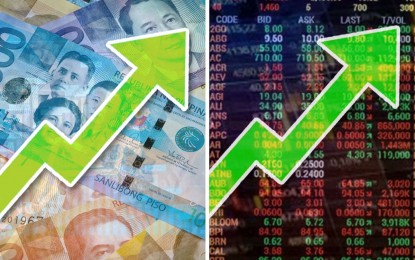
FURTHER HIKES. Both the main equities index and the peso ended Thursday (Jan. 5, 2022) up amid hints for further hikes in the Federal Reserve's key rates. Report about the acceleration of domestic inflation rate for December 2022 to 8.1 percent has minimal impact since this is below expectations, economists said. (PNA graphics)
MANILA – The local bourse’s main index continued its trek on Thursday amidst indications for the sustained tightening moves by the Federal Reserve while the peso appreciated against the greenback.
The Philippine Stock Exchange index (PSEi) gained by 0.64 percent, or 42.83 points, to 6,761.33 points.
All Shares trailed with a jump of 0.38 percent, or 13.38 points, to 3,550.45 points.
Most of the sectoral gauges also rose during the day, led by Financials after it increased by 2.06 percent.
It was followed by Industrial, 0.67 percent; Holding Firms, 0.49 percent; and Property, 0.06 percent.
On the other hand, Mining and Oil shed by 0.82 percent and Services by 0.003 percent.
Volume reached 1.85 billion shares amounting to PHP6.89 billion.
Advancers led decliners at 93 to 84 while 53 shares were unchanged.
“Philippine equities notched another positive close, without any breaks so far this year, as investors looked past the FOMC (Federal Open Market Committee) meeting minutes that showed the Fed (Federal Reserve) would remain aggressive in its policy to tame high inflation,” said Luis Limlingan, Regina Capital Development Corporation (RCDC) head of sales.
Citing some economic data releases, Limlingan said results of the November 2022 job openings and labor turnover (JOLTS) in the US have little changed at 10.5 million.
He said the Institute for Supply Management (ISM) manufacturing index also showed a decline after a 30-month rise, “signaling that interest rate increases may be working to slow the economy.”
The US manufacturing sector contracted last November with an index of 49 percent from month-ago’s 50.2 percent. An index of above 50 shows expansion while those below 50 indicate otherwise.
On the domestic front, Limlingan said that despite the inflation increase to 8.1 percent last December from month-ago’s 8 percent, the highest since November 2008, it is slower than market expectations.
The gains of the local bourse’s main index was mirrored by the peso after it recovered and closed the day at 55.75 from day-ago’s 55.91.
It opened the day at 55.92, almost unchanged from its 55.95 start in the previous session.
It traded between 55.75 and 56.025, resulting in an average of 55.898.
Volume reached USD1.06 billion, lower than day-ago’s USD1.27 billion.
Rizal Commercial Banking Corporation (RCBC) chief economist Michael Ricafort traced the peso’s improvement partly to the slower-than-expected domestic inflation rate for December 2022, the decline in global crude oil prices and the reports about investment commitments from China amounting to around USD22.8 billion, which was made during President Ferdinand R. Marcos’ Jan. 3 to 5 official visit to China.
He said gains of the local equities market’s main index, as well as the correction of the US dollar, befitted the peso.
For Friday, the currency pair is expected to trade between 55.65 to 55.85. (PNA)
